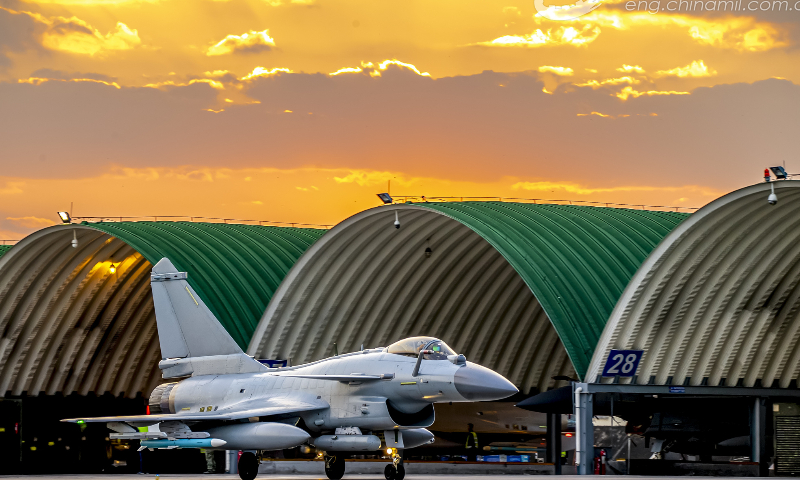
Fighter jets attached to an aviation brigade of the air force under the PLA Southern Theater Command taxi out of the hangers successively in sunset prior to a round-the-clock flight training mission on November 8, 2022. (eng.chinamil.com.cn/Photo by Wang Guoyun)
The YU-20, the latest large tanker aircraft of the Chinese People's Liberation Army (PLA) Air Force, recently hosted aerial refueling exercises for the J-10 fighter jet in a move experts said further displayed the tanker's versatility after it has shown its compatibility with J-20 and J-16 fighter jets.
A PLA Air Force regiment organized a series of drills involving long-range maneuvering, aerial refuel and land attack, in which a group of J-10 fighter jets received hot pit refueling and maintenance on the ground without stopping their engines, while another group of J-10 fighter jets rendezvoused with a YU-20 tanker aircraft in the air and received aerial refueling, China Central Television (CCTV) reported on Monday.
The J-10C and the twin-seat J-10S versions of the J-10 fighter jet participated in the drills, according to the report.
The entire drill session, which stretched from the plains of North China to maritime regions, in the day and at night, lasted about 20 hours, CCTV reported.
Hot pit refueling and aerial refueling are techniques used to shorten the time needed for aircraft to return to combat, a Chinese military expert who requested anonymity told the Global Times on Monday.
In a hot pit refueling, which could also involve munitions reloading, most of the aircraft's functions are kept running so the aircraft can be ready to take off immediately after the process is complete. While an aerial refueling cannot reload munitions for an aircraft, it does not require a landing and takeoff, and it can further increase the range and operating radius of the aircraft, the expert said.
This is also the first time an official report has displayed a YU-20 hosting an aerial refueling for a J-10, as well as the first time an official report has displayed a YU-20 using its refueling point on its tail in an aerial refueling, observers said. Previously, the PLA Air Force has shown the YU-20 hosting aerial refueling for J-20 and J-16 fighter jets with refueling points under its wings.

KJ-500A early warning aircraft Photo: Liu Xuanzun/GT
It shows that the YU-20 is compatible with many different types of aircraft, and it is expected that other types of aircraft with aerial refueling probes, including the KJ-500A early warning aircraft and the H-6N bomber, can also work with the YU-20, the expert said.
The KJ-500A is a new variant of the KJ-500 early warning aircraft that made its debut at the Airshow China 2022 held in Zhuhai, South China's Guangdong Province in early November, and the H-6N is the latest member of the H-6 bomber family, which made first public appearance during the National Day military parade on October 1, 2019 in Beijing.
As with fighter jets, aerial refueling can extend the range, operating radius and flight time for these larger aircraft, which have important tactical and even strategic significance, analysts said.





